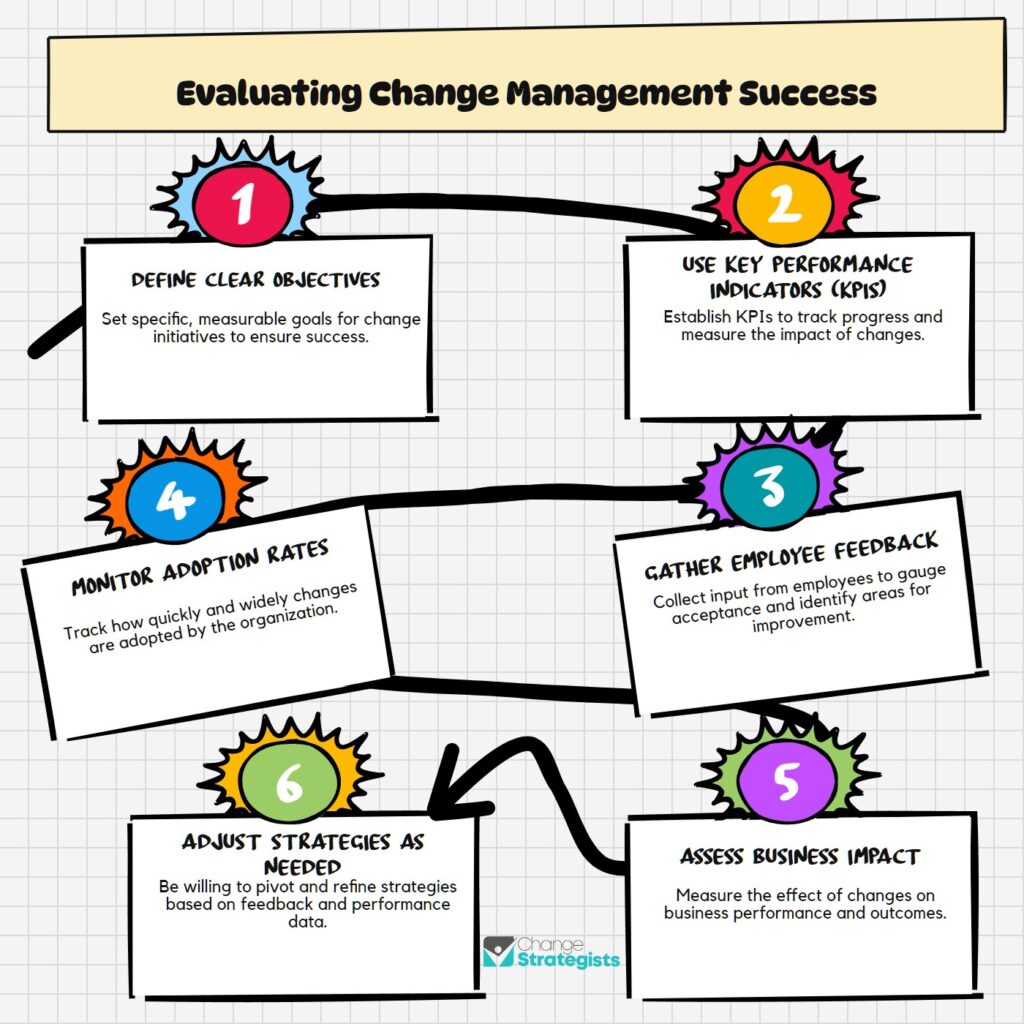


As an affiliate, we may earn a commission from qualifying purchases. We get commissions for purchases made through links on this website from Amazon and other third parties.
If you’re in charge of change management, you know how important it is to measure its effectiveness. Whether you’re introducing new processes, systems, or organizational structures, the goal is to achieve a positive impact. But how do you know if your efforts are working? That’s where measuring change management effectiveness comes in.
Measuring change management effectiveness requires defining clear goals and objectives, identifying key performance indicators (KPIs), tracking progress against those KPIs, and analyzing the impact of change management initiatives on the organization.
Some common KPIs used for measuring change management effectiveness include employee satisfaction, productivity, revenue growth, and customer satisfaction. Regular surveys and feedback from stakeholders can also provide valuable insights into the effectiveness of change management efforts.
In this article, we’ll explore the key metrics you need to track, as well as the tools and techniques you can use to gather data and analyze it effectively. Measuring change management effectiveness is not just about tracking the success of your initiatives; it’s also about identifying areas for improvement. By understanding what works and what doesn’t, you can refine your approach and ensure that your efforts are aligned with your business objectives.
We’ll walk you through the process step by step, from setting key performance indicators (KPIs) to analyzing feedback and identifying opportunities for continuous improvement. Whether you’re a seasoned change management expert or just starting out, you’ll find valuable insights and practical advice to help you measure and optimize your efforts.
Understanding how well your team adapts to new processes can be the key to success when implementing organizational updates. Measuring progress and tracking success is essential to ensure that your change management efforts are effective. If you don’t measure the effectiveness of your change management initiatives, you won’t know if they’re working or not. This can lead to wasted time and resources, and ultimately, failed projects.
Measuring change management effectiveness allows you to quantify the impact of your efforts. This means you can identify what’s working and what’s not, and adjust your approach accordingly. You can also communicate the results of your efforts to stakeholders, which can help build support for future change management initiatives.

Measuring change management effectiveness is also an important tool for continuous improvement. By tracking progress over time, you can identify areas for improvement and make changes to your approach to achieve better results.
Effective change management is critical to the success of any organization. Measuring its effectiveness is a crucial step in ensuring that your efforts are achieving the desired results. By measuring progress and tracking success, you can identify areas for improvement, increase buy-in from stakeholders, and ultimately achieve your goals.
So, take the time to measure the effectiveness of your change management initiatives and use the insights gained to improve your approach and achieve better outcomes.
Let’s dive into the nitty-gritty of tracking progress with KPIs, the bread and butter of gauging how well your transformation is sizzling. Measuring effectiveness is crucial to understand whether your change management efforts have been successful or not.
Effective change management requires the right KPI selection to measure progress. It’s important to identify and choose KPIs that are specific, measurable, relevant, and time-bound. KPI selection plays a vital role in measuring change management effectiveness. It helps to track progress towards the desired outcome, identify gaps, and make necessary adjustments.
The selection of KPIs should be aligned with the organization’s goals, objectives, and vision. It should also consider the resources available to measure and analyze data. The right KPIs provide a clear picture of how the change management process is performing and whether it is meeting the desired objectives.
In conclusion, selecting the right KPIs is a critical aspect of measuring change management effectiveness. It helps to identify areas for improvement and track progress towards the desired outcome. By choosing KPIs that are specific, measurable, relevant, and time-bound, organizations can ensure that change management efforts are successful.
Measuring effectiveness through KPIs provides insights that can help organizations make informed decisions and take necessary actions.
Get ready to gather valuable insights and feedback from your team with surveys, a powerful tool for understanding the impact of your transformation efforts. Survey design is crucial in determining the effectiveness of your change management initiatives.
Create a survey that clearly outlines the purpose and objectives of the assessment. Keep your questions concise and specific to the changes you’ve implemented. Avoid leading questions or questions that may elicit biased responses.
Response rates are also an important factor to consider when measuring the effectiveness of your change management efforts. A low response rate may indicate a lack of engagement from your team and may not provide accurate feedback.
To increase response rates, ensure that your survey is distributed to the right people at the right time. Communicate the importance of the survey to your team and offer incentives or rewards for completing it. Follow up with reminders and thank-you notes to encourage participation.
In summary, surveys are a valuable tool for measuring the effectiveness of your change management efforts. Through effective survey design and high response rates, you can gather valuable insights and feedback from your team. Use this information to make data-driven decisions and improve your change management initiatives.
The Feedback Mechanisms section focuses on ways to gather valuable input and insights from your team to enhance your transformation efforts. Feedback mechanisms are critical to measuring the impact of change management initiatives. Without feedback, you won’t be able to identify areas of improvement or measure the effectiveness of your change management plan.
Here are five ways to gather feedback from your team:
By using feedback mechanisms, you’ll be able to measure the effectiveness of your change management plan and make adjustments as needed. It’s important to remember that feedback is a two-way street, and it’s essential to create an environment where team members feel comfortable providing feedback.
By establishing a culture of open communication and transparency, you’ll be able to gather valuable insights that can inform your change management strategy. Incorporating feedback mechanisms into your change management plan is essential for measuring the impact of your initiatives.
By using a combination of interviews, surveys, focus groups, and collaboration tools, you’ll be able to gather valuable input and insights from your team. Remember that feedback is a continuous process, and it’s essential to establish an ongoing feedback loop to ensure continuous improvement and accountability.
By creating a culture of open communication and transparency, you’ll be able to enhance your transformation efforts and drive positive change within your organization.
You’ll dive into data analysis now, where you’ll sift through numbers and statistics to gain a better understanding of how your initiatives are truly impacting your organization. Data analysis is a crucial step in measuring change management effectiveness because it allows you to identify trends and patterns that may not be immediately apparent.
By analyzing data, you can determine whether your change management initiatives are having the desired effect, and if not, you can make adjustments to improve their effectiveness. One important aspect of data analysis is data visualization. This involves presenting data in a way that is easy to understand and interpret. By using charts, graphs, and other visual aids, you can quickly identify trends and patterns that may not be immediately apparent when looking at raw data.
Data visualization can also help you communicate your findings to others in your organization, making it easier to get buy-in for your change management initiatives. Another important aspect of data analysis is trend analysis. This involves looking at data over time to identify patterns and trends. By analyzing trends, you can determine whether your change management initiatives are having a sustained impact on your organization.
Trend analysis can also help you identify areas where you may need to make adjustments to your change management strategy to ensure that you are achieving your desired outcomes. By using data visualization and trend analysis, you can gain a deeper understanding of how your change management initiatives are impacting your organization, and make data-driven decisions to improve their effectiveness.
To effectively manage change, it’s important to identify and engage key stakeholders who are impacted by the change.
To do this, you need to communicate effectively with them, keeping them informed of what’s happening and why it’s happening. Addressing any concerns or feedback they may have is also crucial, as it helps build trust and credibility in the change process.
By following these steps, you can ensure that stakeholders are fully engaged and supportive of the change, leading to a more successful implementation.
Engaging with the right stakeholders from the start and fostering open communication channels will help you better understand the impact of any modifications and increase the likelihood of successful implementation.
Identifying key stakeholders is crucial to the success of any change management initiative. These stakeholders can be individuals or groups who are directly or indirectly affected by the change. It’s important to engage with them early on in the process to ensure their needs and concerns are addressed, and to gain their support for the change.
Once you’ve identified your key stakeholders, it’s important to engage with them in a way that’s effective and meaningful. This involves establishing clear communication channels and ensuring that stakeholders are kept informed throughout the change management process.
Regular updates and feedback sessions can help to build trust and ensure that stakeholders feel valued and heard. By engaging with your key stakeholders in a proactive and collaborative manner, you can increase the likelihood of a successful change management initiative.
Now that you’ve identified and engaged your key stakeholders, the next step is to communicate effectively with them. Effective communication is crucial in change management because it ensures stakeholder alignment and buy-in. Without effective communication, stakeholders may feel left out and not understand the changes being made, leading to resistance and ultimately, project failure.
To communicate effectively with stakeholders, it’s important to understand their communication preferences and needs. One way to do this is to create a stakeholder communication plan that outlines what information needs to be communicated, who needs to receive it, and how often. This plan should include different communication channels, such as email, meetings, and social media, to ensure that all stakeholders receive the information they need in a format that works for them.
Additionally, it’s important to actively listen to stakeholder feedback and adjust communication strategies accordingly. To create an effective stakeholder communication plan, consider the following:
To ensure stakeholder alignment, use the following communication strategies:
By communicating effectively with stakeholders and aligning their needs with the project goals, change management can be more effective and successful.
Oh, you don’t wanna hear about how to address stakeholder concerns and feedback, do ya? After all, who cares about keeping your stakeholders happy and informed? Just let ’em figure it out themselves and see how far your project goes.
But wait, before you dismiss the importance of stakeholder management, consider this: stakeholders can make or break your change management initiative. They have the power to influence the success or failure of your project, and their concerns and feedback can provide valuable insights that can improve your change management strategy.
To effectively address stakeholder concerns and feedback, you need to have a feedback analysis process in place. This involves collecting feedback from stakeholders, analyzing the data, and using the insights to improve your change management plan.
One way to collect feedback is through surveys or interviews. You can also gather feedback through social media or online forums. Once you have collected feedback, it’s important to analyze it to identify common themes or issues that need to be addressed.
This information can then be used to refine your change management plan and improve stakeholder engagement. So, don’t underestimate the importance of stakeholder management and feedback analysis in measuring the effectiveness of your change management initiative.
The success of implementing new strategies relies heavily on employees’ willingness to adopt and adapt to changes in their roles and responsibilities. Change resistance is a common obstacle that organizations face when implementing new changes or initiatives. It’s important to address the concerns and feedback of employees during the change management process to ensure they feel valued and heard.
Employee engagement is crucial in this process as it can help reduce resistance and increase buy-in from employees. To ensure change adoption and adaptation, it’s important to provide employees with the necessary resources and training. This can include workshops, training sessions, and tools to help employees understand and navigate the changes.
It’s also important to communicate the reasons for the changes and how they align with the organization’s goals and values. This can help employees see the bigger picture and feel more invested in the changes. Measuring change adoption and adaptation can be done through various methods such as surveys, focus groups, and feedback sessions.
These methods can provide valuable insights into how employees are adapting to the changes and what areas may need improvement. It’s important to continuously monitor and evaluate the effectiveness of change management strategies to ensure they’re achieving the desired outcomes. By prioritizing employee engagement and providing the necessary resources and training, organizations can increase the likelihood of successful change adoption and adaptation.
Successfully implementing new strategies relies heavily on employees’ willingness to adopt and adapt, which can have a significant impact on achieving business objectives. Measuring the effectiveness of change management requires a careful analysis of employee engagement and performance metrics.
Employee engagement is a key factor in determining the success of a change initiative. The more engaged employees are, the more likely they are to embrace the change and contribute to its success.
Performance metrics provide a quantitative measure of the impact of change management on business objectives. These metrics should be carefully selected to align with the specific goals of the change initiative.
For example, if the goal is to increase revenue, the performance metrics might include sales figures, customer retention rates, and profit margins. On the other hand, if the goal is to improve efficiency, the metrics might focus on process time, cost savings, and productivity.
In conclusion, measuring the impact of change management on business objectives requires a comprehensive analysis of employee engagement and performance metrics. By carefully selecting and monitoring these factors, organizations can determine the effectiveness of their change management initiatives and make necessary adjustments to achieve their desired outcomes. Ultimately, the success of any change initiative depends on the willingness of employees to embrace the change and contribute to its success.
To improve your change management effectiveness, you should focus on continuous improvement. This involves identifying areas for improvement, implementing strategies for improvement, and monitoring and evaluating their effectiveness.
By continuously striving for improvement, you can ensure that your change management processes are always evolving and adapting to meet the needs of your business.
You can pinpoint the areas that need improvement by identifying where you’re falling short in implementing new practices and contrasting them with areas where you’ve been successful in maintaining existing ones.
To achieve this, conduct a process evaluation to determine how well the new practices have been integrated into your current processes. This will help identify any gaps or challenges that need to be addressed in order to effectively implement the new practices.
Additionally, assess your organization’s change readiness by evaluating the level of employee engagement and willingness to adopt the new practices. This can be done through surveys, interviews, and focus groups.
Once you’ve identified the areas that need improvement, it’s important to take action to address them. Start by prioritizing the areas that have the biggest impact on achieving your goals.
Then, create an action plan that outlines specific steps to address each area. This plan should include timelines, responsible parties, and measurable goals to track progress.
Finally, monitor and evaluate the effectiveness of the changes you implement. This will help ensure that your efforts are making a positive impact and allow you to make adjustments as needed to continue improving.
If you want to continuously improve your organization, it’s crucial to implement strategies that foster a culture of innovation and growth. One of the keys to implementing continuous improvement is having a structured approach to change management planning.
This means having a well-defined process for identifying areas of improvement, developing action plans, and monitoring progress. It also means having a set of metrics in place to measure the effectiveness of your change management efforts.
Continuous improvement implementation involves a range of strategies, including training and development programs, process improvement initiatives, and technology investments. It’s important to prioritize these initiatives based on their potential impact on the organization and the resources required to implement them.
A continuous improvement culture is built on a foundation of ongoing learning and development, so it’s essential to provide your employees with the tools and resources they need to succeed.
By taking a structured approach to change management planning and implementing a range of continuous improvement strategies, you can create a culture of innovation and growth that will help your organization thrive in today’s fast-paced business environment.
As you strive to continuously improve your organization, it’s essential to regularly assess and analyze the impact of your improvement strategies to ensure they’re contributing to the growth and success of your business. Continuous monitoring is an important step to identify the effectiveness of your improvement strategies.
With a proper evaluation framework, you can measure your progress and identify areas for improvement. When monitoring and evaluating the effectiveness of your improvement strategies, it’s important to establish clear goals and objectives. This will help you measure the impact of your strategies and determine whether they’re meeting your expectations.
Additionally, you should establish a system for collecting and analyzing data to measure the effectiveness of your strategies. This data can be used to identify trends, patterns, and areas for improvement. By continuously monitoring and evaluating your improvement strategies, you can ensure that your organization is on track towards achieving its goals and objectives.
In the end, it’s about finding ways to truly understand the impact of your efforts and continuously improve. Measuring ROI is an essential tool for assessing change management effectiveness. ROI is a financial metric that shows what you gained from an investment compared to what you spent.
When it comes to change management, ROI can help you determine if the changes you made were worth the cost. However, measuring ROI is not the only way to assess change management effectiveness. It’s also essential to consider future implications. You need to ask yourself, “Will the changes we made be sustainable in the long run?” If not, then you may need to rethink your strategy.
Change management is not a one-time event; it’s an ongoing process. It’s crucial to evaluate the long-term impact of your efforts to ensure that the changes you made are sustainable. In conclusion, measuring change management effectiveness is a crucial step in ensuring that your efforts are making a positive impact.
Measuring ROI and considering future implications are two essential tools for assessing change management effectiveness. Remember that change management is an ongoing process, and it’s essential to continuously evaluate the impact of your efforts to ensure that the changes you made are sustainable in the long run. By doing so, you can continuously improve and make a positive impact on your organization.
When evaluating the success of effective change management strategies, various metrics can be used to measure their effectiveness. These may include employee engagement levels, turnover rates, productivity, and financial performance. By tracking these metrics, organizations can gauge the impact of their change management efforts and make adjustments as needed.
Congratulations! You’ve successfully reached the end of this informative article on measuring change management effectiveness.
You must have noticed that change management is a complex process that requires continuous improvement and evaluation. It’s crucial to measure the effectiveness of change management to achieve business objectives and ensure that the changes implemented are producing the desired results.
In summary, measuring change management effectiveness involves collecting and analyzing data through key performance indicators, surveys, and feedback mechanisms. It also involves evaluating the impact of changes on business objectives and ensuring that the changes are adopted and adapted by the organization.
Remember that continuous improvement is crucial in measuring change management effectiveness, and it’s recommended to adopt a proactive approach to ensure that you’re always ahead of the game.
Keep up the good work!
About the author
If you want to grow your business visit Growth Jetpack program. And if you want the best technology to grow your online brand visit Clixoni.




Fortifying IT services with a structured change management approach can significantly reduce errors and downtime, but how do you make it a reality? Read more

Navigate your career with essential organizational change management certifications, unlocking a world of opportunities and expertise—find out how these certifications can transform your journey. Read more

Kickstart your understanding of AI's transformative impact on change management and discover the future of organizational evolution. Read more
As an Amazon Associate, we earn from qualifying purchases. We may get commissions for purchases made through links
This site is operated by: Mark J Draper
Phone:
UK: +44 0161 527 3797
USA: +1 888 387 3816